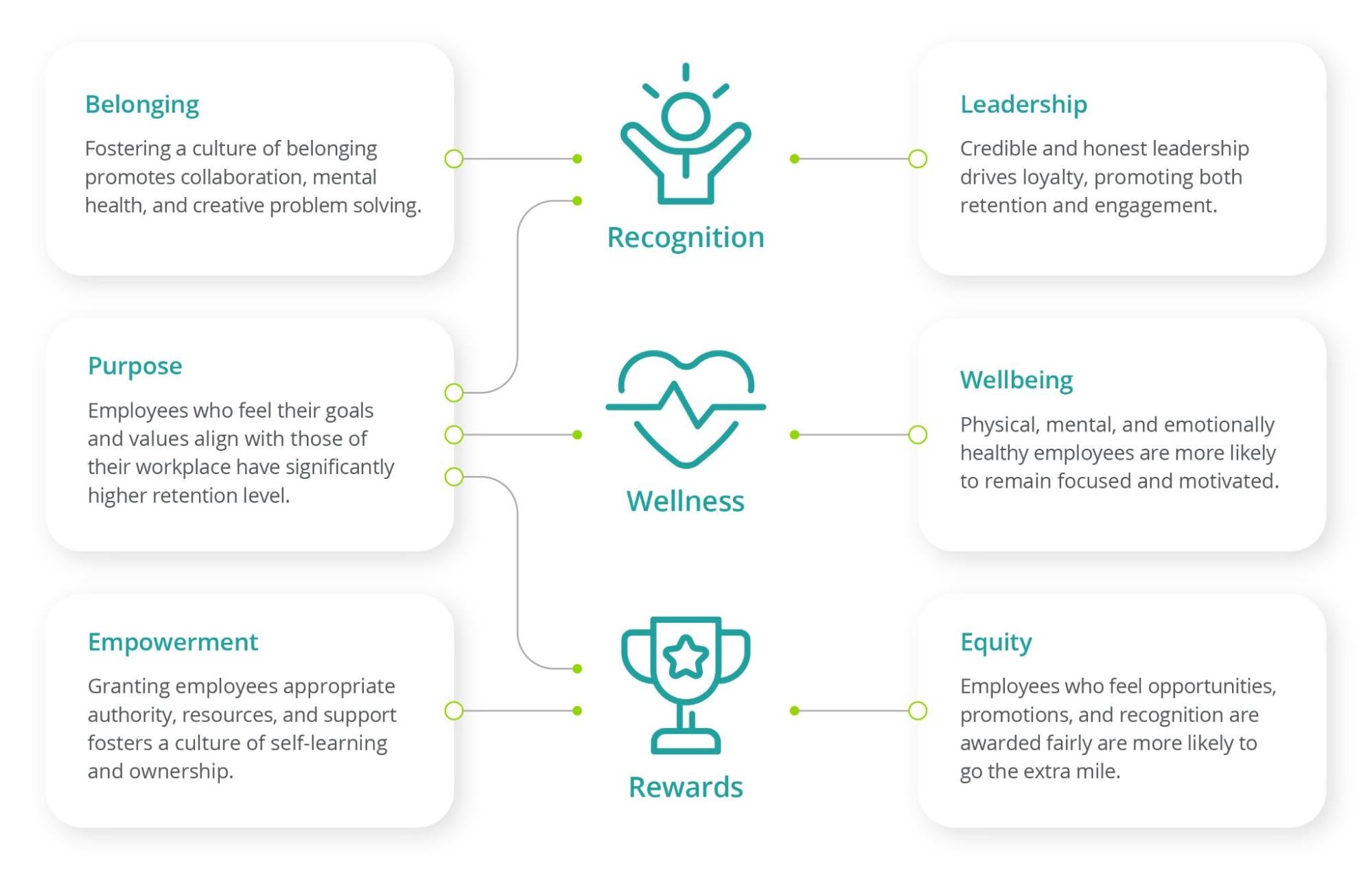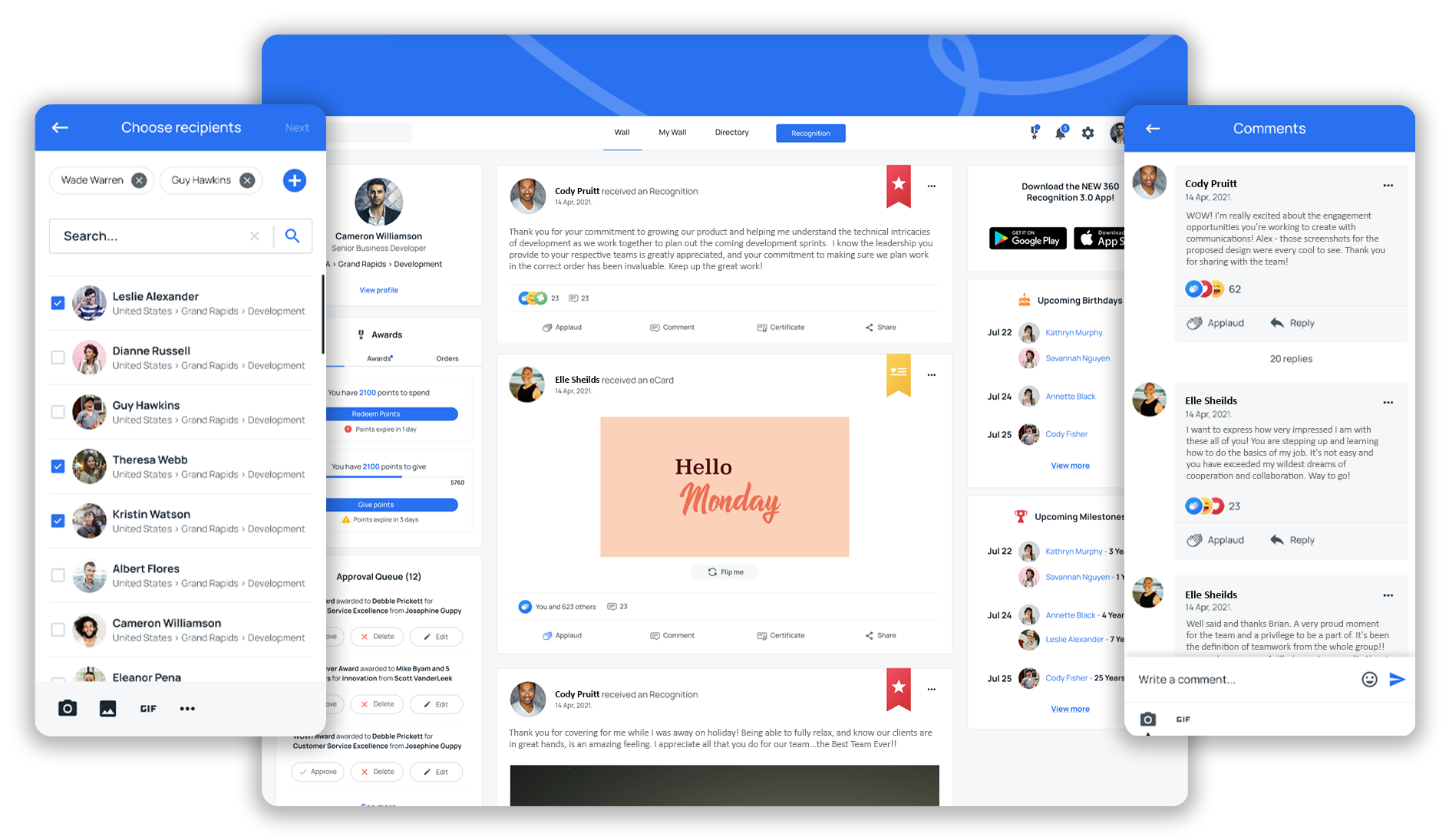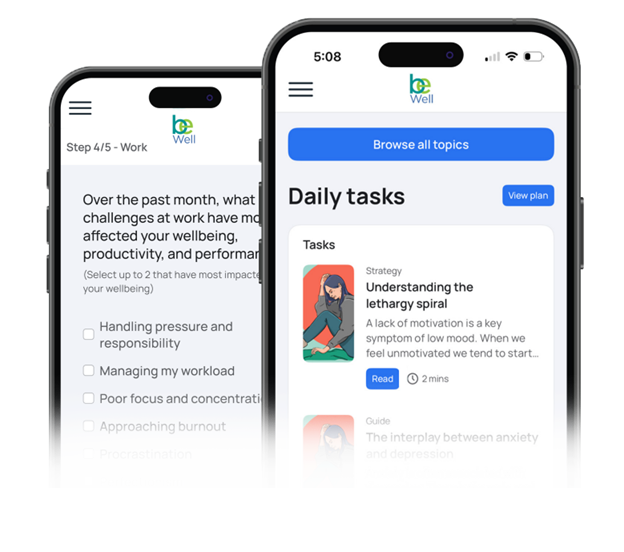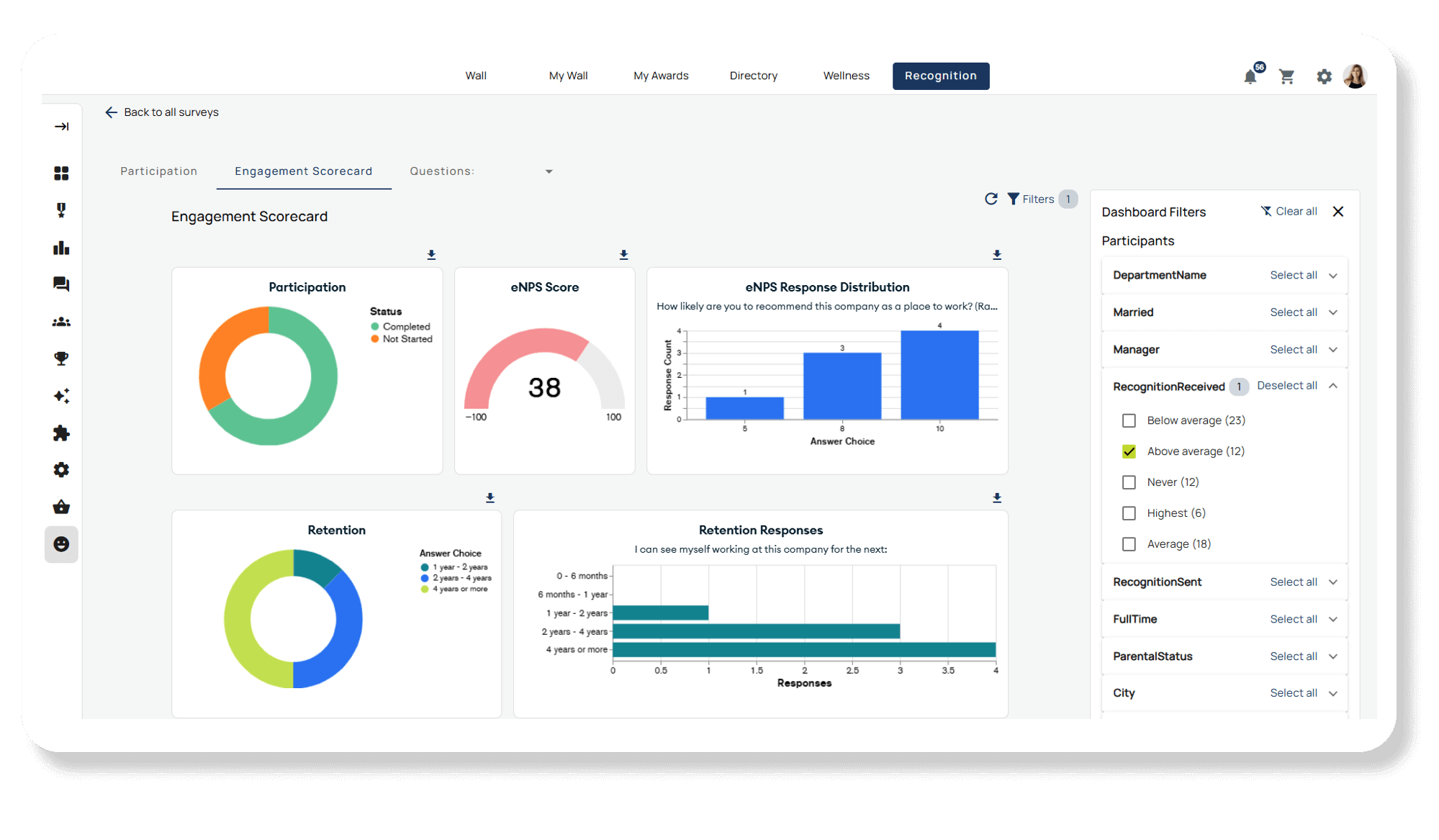April 11, 2025

Employee engagement has always been a critical aspect of any business’s success, but in 2025, it’s taken on a whole new meaning. Employees today are demanding more from their employers than ever before, and only the companies that are listening are thriving.
But rather than looking at this as a dark omen for your bottom line, business leaders should instead focus on re-engaging employees and building highly engaged workplaces. Engaged employees perform better and contribute significantly to business success, leading to lower absenteeism, fewer workplace injuries, and overall improved organizational outcomes.
Considering all this, what can organizations do to connect and engage workers, and build a thriving culture during a time when everyone seems to want to leave?
Understanding Employee Engagement
Employee engagement is a critical aspect of a company’s success, impacting profitability, revenue, customer experience, employee turnover, and more. It is the level of enthusiasm and dedication a worker feels toward their role and the goals of the organization.
Workplace engagement is crucial in driving employee satisfaction and organizational success. Engaged employees are not just satisfied with their jobs; they are emotionally invested in their work and committed to the company’s success. This emotional connection drives them to go above and beyond in their roles, contributing to a positive workplace environment and better business outcomes.
Employee Engagement Definition
Employee engagement is defined as the involvement and enthusiasm of employees in their work and workplace. It helps measure and manage employees’ perspectives on the crucial elements of the workplace environment.
An employee engagement model is a structured framework used to assess and enhance employee engagement levels within organizations, providing actionable insights and guiding improvements.
Engaged employees are actively involved in their work, showing a genuine interest in their tasks and a commitment to the organization’s goals. They are not merely putting in their time; they are passionate about their work and strive to make meaningful contributions.
This level of engagement is essential for fostering a positive workplace environment and achieving organizational success.
Importance of Employee Engagement
Employee engagement is vital to any business, regardless of size or financial standing. Employees are a company’s biggest asset, and their engagement is crucial for success. Companies that value their employees will reap the rewards of a dedicated, passionate, and skilled workforce.
Defining and instilling a company's values can significantly enhance employee engagement and accountability. Clear values inspire employees and provide a framework for expected behaviors, fostering a positive work culture. Engaged employees are more productive, provide better customer service, and are less likely to leave the company.
This reduces employee turnover and the associated costs of hiring and training new staff. Moreover, engaged employees are more likely to contribute to a positive company culture, which can attract top talent and enhance the company’s reputation.
1. Improved Productivity
Engaging employees leads to higher productivity, with engaged employees being 21% more productive than their disengaged counterparts. Source: Gallup, State of the Global Workplace
2. Better Performance & Innovation
Business executives recognize that highly engaged business units see up to 59% less turnover and 41% lower absenteeism, contributing to more stable, high-performing teams. Source: Gallup
3. Higher Employee Retention Rates
Higher employee retention rates are a direct result of improved employee engagement. When employees feel valued, supported, and engaged, they are more likely to stay with the organization long-term.
In fact, a study by Gallup found that highly engaged employees are 26% less likely to leave their job. This not only saves the organization the cost of recruiting and training new employees but also preserves the knowledge and expertise of existing employees.
3. Higher Employee Retention Rates
Companies with engaged employees experience 18% lower turnover in high-turnover industries and 43% lower turnover in low-turnover industries compared to those with merely satisfied employees, who may feel content but lack the motivation to exceed expectations or innovate. Source: Gallup

4. Enhanced Employee Wellbeing
Engaged employees report 66% higher overall wellbeing than actively disengaged ones, partly due to opportunities for professional growth, and are less likely to experience burnout. Source: Gallup & Harvard Business Review
5. Positive Company Culture
Organizations with high employee engagement scores are 2.5 times more likely to be considered a great place to work, as engagement initiatives positively impact the entire organization. Source: Great Place to Work Institute
6. Stronger Business Results
Companies in the top quartile for employee engagement are 23% more profitable and 10% more customer-focused than those in the bottom quartile. Source: Gallup
By focusing on employee engagement, companies can create a positive work environment that drives company success and enhances employee satisfaction.
Drivers of Employee Engagement
Employee engagement is influenced by many factors, including workplace culture, organizational communication, and managerial styles. Understanding these drivers is essential for developing effective employee engagement strategies.
However, many employee engagement efforts fail largely due to misconceptions about ownership and implementation. Engagement is often viewed as solely an HR responsibility, leading to a lack of accountability among leadership, which ultimately results in ineffective strategies that do not address the core needs of employees.
By addressing the key drivers of engagement, organizations can create a work environment that motivates and inspires employees, leading to higher productivity, better retention, and overall business success.
Key Drivers of Employee Engagement

Purpose:
Employees want to feel that their work is meaningful and contributes to the organization’s mission. When employees understand how their roles align with the company’s goals, they are more likely to be engaged and motivated.
Empowerment:
Empowerment gives employees the authority, resources, and support they need to make decisions. This fosters a culture of self-learning and ownership, reducing micromanagement and preparing future leadership.
Leadership:
Employees want to feel supported and valued by their manager. Managers who show genuine concern for their employees’ well-being and provide regular feedback can significantly enhance engagement le
Belonging:
Employees want to feel that their work is meaningful and contributes to the organization’s mission, which is crucial for a company's success. When employees understand how their roles align with the company’s goals, they are more likely to be engaged and motivated.
Well-Being:
Physical, mental, and emotionally healthy employees who have opportunities for personal growth are more likely to remain focused and motivated, encouraging supportive collaborations and greater capacity for challenging obstacles and problem solving.
Equity:
Employees want opportunities for professional growth and development. Providing career development opportunities and training programs can help employees feel valued and invested in their future with the company.
By understanding the drivers of employee engagement, organizations can develop strategies to improve engagement and increase productivity, retention, and overall business success.
5 Ways to Improve Employee Engagement
Research now supports what HR leaders have known: engaged employees are less likely to quit. One effective approach is to implement practical employee engagement ideas. In fact, some studies show that engaged employees are 87% less likely to leave their job than disengaged employees.
1. Build a Culture of Recognition
One way to improve employee engagement is through employee recognition. According to a study by Quantum Workplace, when employees believe they’ll be recognized for their work, they’re 2.7 times more likely to be highly engaged.
Furthermore, research from Forbes has found that companies scoring in the top 20% for their culture of recognition had turnover rates 31% lower. Conversely, according to a study by OGO, 82% of American professionals feel that they aren’t adequately recognized for their contributions.
This discrepancy shows us employees are craving recognition, but they aren’t getting enough of it. Employees crave feedback as a crucial component of workplace engagement and satisfaction. Effective analysis of employee feedback, such as check-ins and pulse surveys, can highlight this need and inform actionable insights for recognition programs.
It’s understandable – managers have full plates and oftentimes recognition falls off the to-do list. Or maybe managers simply don’t know how to best recognize their employees in a way that resonates.
This is where a recognition program, especially one with a peer-to-peer element, can help.
An online recognition platform streamlines what actions to recognize and when. It allows managers and leaders to publicly celebrate employees’ contributions, but it also encourages peers to recognize each other.
This helps give employees ownership in the process and can even highlight some unsung heroes on the team who may have been overlooked in the past.
Furthermore, with over half of US employees working remotely, an online recognition platform allows in-office and remote workers to always stay connected. This is critical for building community regardless of where people physically work.
2. Building Employee Engagement with Wellness
Over the past two years, we’ve become all-too-well acquainted with the cost of taking sick days. Aside from the obvious physical toll, it slows productivity, disrupts communication, and can halt projects in their tracks. Not to mention the strain chronic illness puts on rising health care costs.
It’s not a groundbreaking concept that healthy employees save companies money in more ways than one. Enhancing the employee experience through wellness initiatives is crucial for fostering engagement, trust, and a positive workplace culture.
But what may be a new concept for many organizations is mental wellness. Measuring employee engagement is crucial to track the effectiveness of wellness programs and ensure they meet employees’ evolving needs.
The Centers for Disease Control estimates depression causes 200 million lost workdays each year, at a cost of $17 to $44 billion to employers. Meanwhile, the WHO reported a 25% worldwide increase in anxiety and depression in March of 2022. Furthermore, a 2021 study from Indeed found that 52% of workers say they’re feeling burned out.
The data shows what many of us already know: Our employees are struggling.
So, what can employers do to combat this? For starters, offer a comprehensive wellness program, like Terryberry's Be Well program. While many companies have a physical wellness program in place, research shows these programs don’t hold significant weight when it comes to a return on investment.
3. Teambuilding Initiatives and Employee Engagement Strategies
Teambuilding may bring back memories of elementary school for some, but it’s a concept that shouldn’t be left in the past. Teambuilding helps foster camaraderie, trust, and engagement – critical aspects of any successful team.
A well-crafted engagement strategy is essential in this regard, as it involves thoughtful planning and actionable steps to enhance onboarding experiences and improve communication. Middle managers play a crucial role in these initiatives by empowering their teams and communicating company values.
In fact, research has found organizations that promote collaboration and communication are 4.5 times less likely to lose their best employees.
But what used to be as simple as a regular get-together outside of the office, is less straightforward in a world of hybrid and remote work. So, what can companies do to build trust and engagement amongst hybrid teams?
First of all, you need to start with your lowest common denominator. If one person on your team is remote and the rest is in the office, your activities still need to be remote-friendly. Video chats will be your best asset here.
Consider having a virtual team dinner. Send your team a gift card for a food delivery service, like Doordash or Uber Eats. Have your team order their food to their home and enjoy together over Zoom.
This will give you the opportunity to discuss each person’s favorite foods, best local restaurants, and what possibly open people up to new cuisines.
Additionally, you can play a game virtually too. Try trivia, Pictionary, or a discussion game like Two Truths and a Lie. These are great ways to get to know the team as people instead of just coworkers.
4. Prioritize Onboarding
The onboarding process can set the tone for an employee’s experience at a new company, for better or worse. In fact, according to a study by SHRM, 25% of a company’s new hires leave within a year if the onboarding experience was poor.
Why not take the opportunity to make this experience beneficial to everyone involved?
When it comes to building an onboarding process, start with establishing your goals and priorities. Chances are, reviewing the employee handbook isn’t the most critical aspect of your onboarding experience, so don’t focus there.
Instead, consider focusing on integrating your new hire into your company’s culture, communicating the organization’s mission, and empowering them to see a future with your company.
One way to do this is with a 90-day mentor or sponsor. Pairing a new hire with a seasoned employee will provide the new person with a built-in resource for questions and guidance.
As an added bonus, the more experienced person may gain a new perspective and be able to spot areas where the company could improve. Seeing a happy, successful tenured employee can also provide your new hire with a vision for a future with your company.
Additionally, don’t wait to get your new hire in meetings and participating in projects. While paperwork is necessary, human interaction is what builds trust and engagement for new employees.
Set up meet-and-greet meetings for new hires to get introduced to key people. This will help clearly identify roles and responsibilities early, while building relationships.
Lastly, don’t abandon your new hire too early. Studies suggest that longer onboarding programs are associated with stronger talent and higher employee engagement. It’s important that onboarding guides your new hire beyond the first week and instead ensures they feel confident and connected at their new job.
5. Employee Feedback and Surveys
When it comes down to it, asking your employees what they want is the simplest way to improve employee satisfaction. You’ll never actually know what their experience is like until you ask.
This is where employee engagement surveys can be an impactful tool, as they measure and enhance workplace dynamics by providing insights into employee commitment, motivation, and sense of purpose.
Tailoring employee engagement survey questions to different audiences within your organization is crucial. These questions should delve into deeper motivators like purpose, development, and managerial relationships that truly influence engagement levels. Terryberry's survey solution, Be Heard, offers:
- Engagement Surveys - Provide a baseline, rooted in people science, that measures your employees’ level of engagement.
- Pulse Surveys - Allow you to deploy real-time, quick-to-action, surveys on topical areas that can drive data backed decisions.
- User-Friendly Interface: Intuitive design that makes it easy for employees and managers to navigate and engage with the platform.
- Robust Analytics: Gain insights from detailed analytics to track engagement trends and measure the impact of your programs.
- Easy Integration: Automate HR tasks and integrate with other workplace tools like your HRIS, Microsoft Teams, Outlook, Gmail, and more.
Keep in mind, anonymous responses will typically be more honest, so consider what information you’re truly trying to gather with your survey.
Also consider sending surveys regularly. Annually may be often enough, but it may be a better fit to send surveys twice a year or even quarterly. Just be careful to avoid sending too frequently and risk losing participation.
You may also be tempted to avoid sending surveys during difficult times, like a recession or downsizing. But this may be the best time to ask for feedback. It can show your team that you understand difficult times take a toll and you care about the well-being of your employees.
And remember: surveys can provide insightful information, but it’s critical that leaders use this information to enact change. Sending surveys without action afterwards will just foster resentment and distrust amongst your team.
Next Steps
Interested in learning more about how your company can benefit from choosing the right employee engagement platform for recognition and wellness programs? Schedule a demo of Terryberry’s employee engagement platform today.




